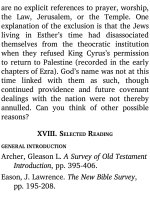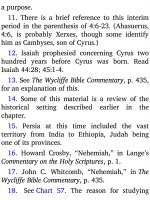Jensens survey of the old testament adam 527
Bạn đang xem bản rút gọn của tài liệu. Xem và tải ngay bản đầy đủ của tài liệu tại đây (117.75 KB, 4 trang )
Paul’s signature reached them with the
message that the day of the Lord had
arrived,12 they were prone to believe it,
because of the severe persecution they were
going through. But that raised a real
problem: If the day of the Lord had already
arrived, what about the rapture that Paul
had foretold in his letter? Had it taken
place, and were they left behind? So in
chapter 1 Paul interprets the meaning and
purpose of persecution and a iction for
saints before the rapture (cf. Heb. 10:32-39).
The word tribulation(s) appears twice in
this passage. It should not be confused with
the Tribulation period (or the Great
Tribulation period), which shall transpire
between the rapture and the revelation
(Matt. 24:21) (cf. Chart 91, p. 356). Read
the following verses where the word has
reference to various kinds of trials that
Christians are called upon to endure in their
daily walk: John 16:33; Romans 5:3; 12:12;
2 Corinthians 1:4; 7:4; Ephesians 3:13; 1
Thessalonians 3:4.
Ultimate judgment of all unbelievers will
fall at the great white throne judgment
(Chart 91). Read Revelation 20:11-15 for
the description of that most awesome and
tragic event. That is the background to
verses 8-10 of this Thessalonian passage.
B. BEFORE THE REVELATION:
ANTICHRIST (2:1-17)
Chapter 2 is the crux of the second letter.
Here Paul treats the problem vexing the
Thessalonian
Christians.
The
passage
contains one of the New Testament’s fullest
descriptions of the activity and defeat of
Antichrist, called the “man of lawlessness
[sin]” in 2:3. (See Chart 96.) The chapter’s
main point is that the day of the Lord will
not come until the Antichrist has rst been
revealed and worshiped as God by the
world.
This is the background of Paul’s
instructions in chapter 2:
1. In the rst letter, Paul instructed the
Thessalonians to expect a sudden rapture,
when deceased and surviving believers
would be caught up to be with Christ
forever (1 Thess. 4:13-18).
2. In the same letter, Paul wrote that the
day of the Lord — a time of judgment for
unbelievers — would come upon the
unbelieving world unannounced, “just like a
thief in the night” (1 Thess. 5:1-3).
3. After receiving that letter, the
Thessalonians had continued to be sorely
persecuted for their faith. False teaching was
circulating that the day of the Lord had
already
come
and
brought
the
Thessalonians’ tribulations. The church’s
natural questions were, Did not Paul write
and say that we would be raptured? How,
then, could the day of the Lord be upon us?
4. So Paul wrote the second letter,
instructing the church that the persecutions
they were experiencing were not to be
confused with the judgments of the day of
the Lord against unbelievers. That was yet to
be (2 Thess. 1:7-9). “Now, concerning your
confusion about how the rapture relates to
all of this: don’t be misled or disturbed by
any kind of false teaching. The day of the
Lord has not come yet. That day will not
come until after two things have happened:
rst, the rise of the great rebellion against
God, and then the appearance of the man of
sin, the instigator of the rebellion.”13
5. The aim of the apostle in this chapter,









